The Sticky Rice Club
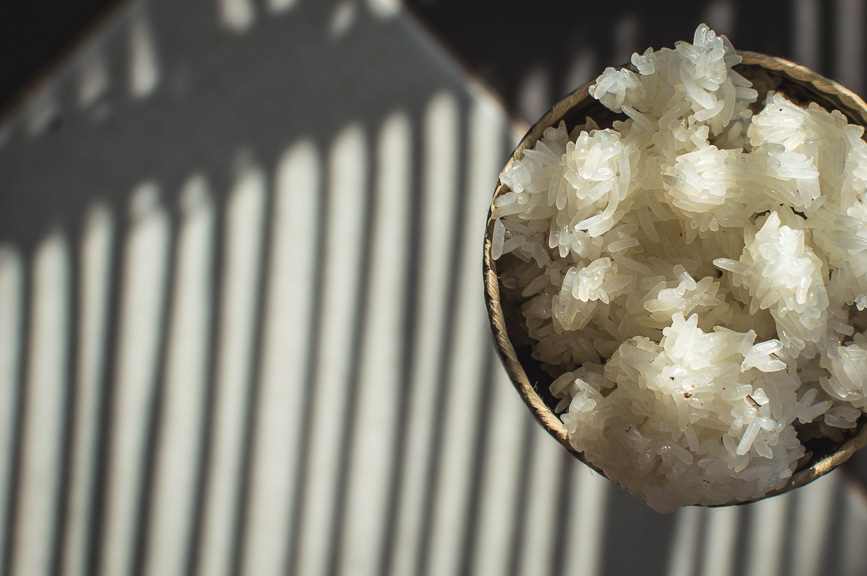
My name is Gabriella and I’m a sticky-rice-aholic.
In fact since leaving Laos, I think I am suffering from a serious case of withdrawal.
It is a relationship that is pure. No fancy contraption is needed, no spoon, fork or chopstick, just you and your ball of sticky rice.
Some people prefer the simple bowl of white rice that we consumed every day in China, each grain a distinct individual, fluffy and light; but glutinous rice (latin: oryza saliva var. glutinosa) a.k.a. sticky rice, doesn’t just dissolve in your mouth, it gives your jaws something to work on and rewards you for the hardwork too. It is heavier, heftier and well, gloriously sticky.
It is the default choice of rice in Laos, not an exception to the rule. Except for a few more “recently” migrated groups such as the Chinese Lenten who still prefer using chopsticks and the accompanying long-grain rice, most of the country is digging into baskets of chewy khao niaow. The very essence of being Lao is in the act of eating sticky rice – often they refer to themselves as “luk khao niaow” meaning “the children of sticky rice“.
Each mouthful is nutty with coconut undertones and the best part is you can eat it with your hands.
I could eat a small bucket of khao niaow on my own if I wanted to. I wouldn’t, but I could.
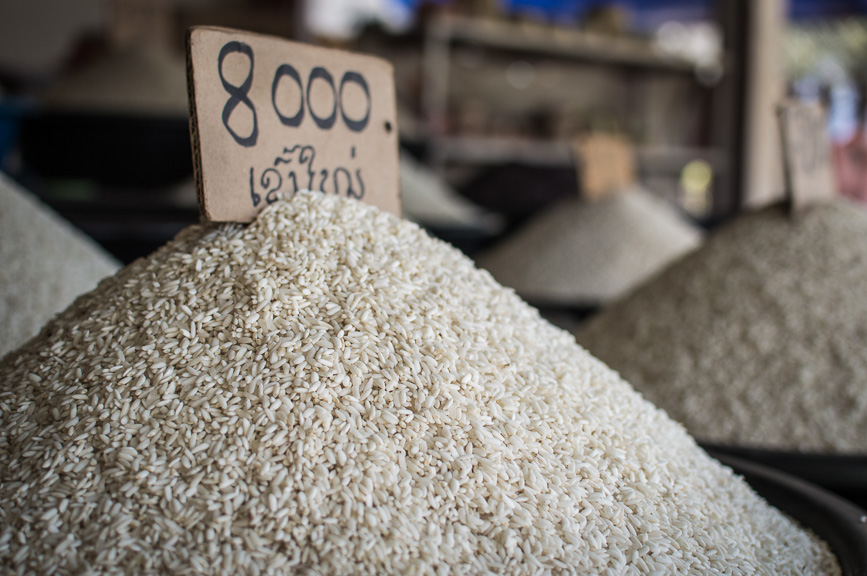
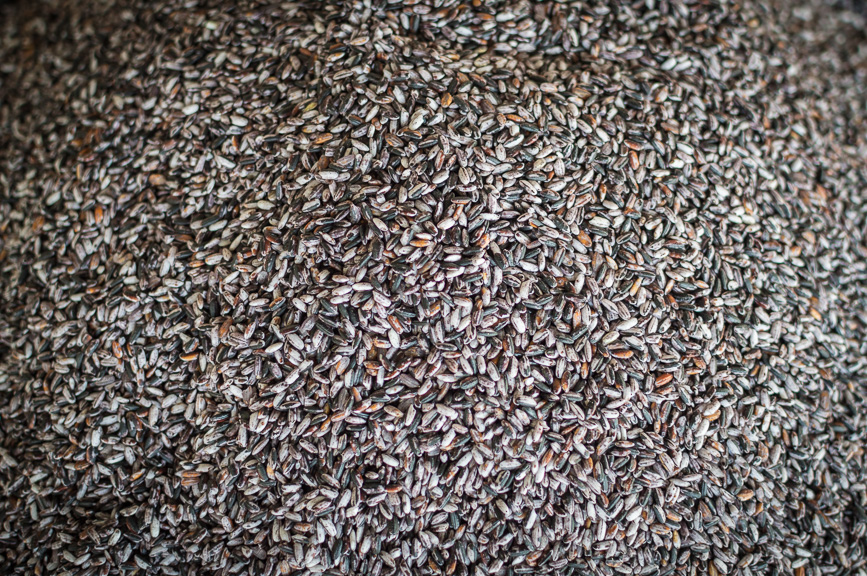
For many of us, the idea of sticky rice is limited to the well-known Thai dessert – Mango with coconut cream and sticky rice. It is delicious, but so far from being the only way to eat this grain. Lao cuisine is still unknown in most of the world compared to the cooking of some of its more famous neighbours llke Vietnam and Thailand, but many of the Thai dishes that people love and know well like som tam – papaya salad actually originate from the region that is now Laos. I could talk your ear off about other Lao highlights such as the slurp-tastic Khao Poon noodles or the rich Orlam stew, but the most underrated of them all is khao niaow.
Khao means rice and Niaow means sticky. Glutinous rice is grown all over Asia, but the largest proportional percentage of consumption and cultivation is in Laos. The growing of khao niaow has been recorded in the region for at least 1100 years. When everyone else switched to improved non-glutinous rice varieties for higher yields during the Green Revolution, Lao farmers rejected the change and chose to stick to their sticky favourites.
Now before we all put up our gluten-free badges of resistance, khao niaow can happily jump onto the modern trend band-wagon, because despite the misleading name, it is completely gluten-free like any other type of rice. And if you want to add some colour to your dish, it also comes in blacks and purples. Glutinous rice has high amounts of amylopectin which gives the grains their clinging personality, each grain lovingly attached to the other. It is not the most nutrient-rich grain, but oh-so-tasty.
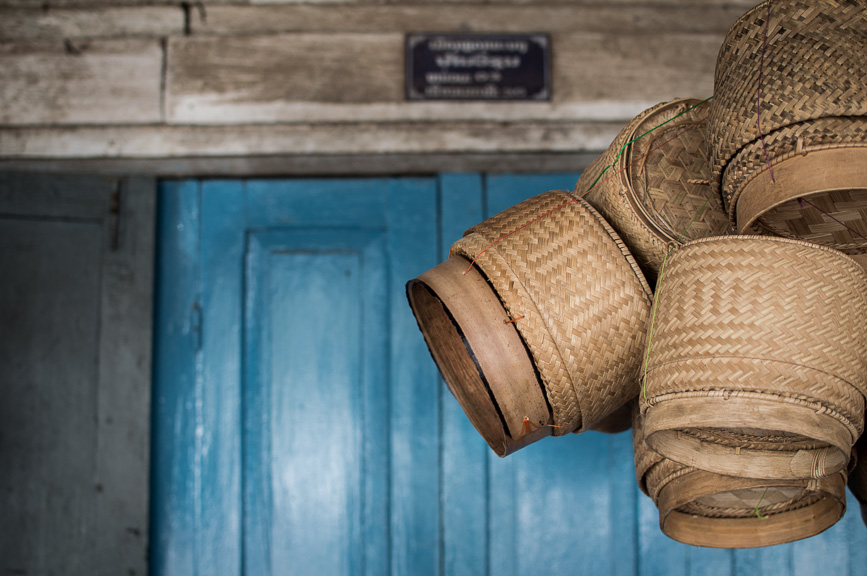
It is also extremely portable. When cooked and cooled, khao niaow is often stored in intricately woven bamboo baskets – tip khao ຕິບເຂົ້າ, ready to be eaten at any time of day. Within the household or at a street food stall, you’ll often find a large basket containing rice for the whole day. The variety of basket sizes also meant farmers could take it with them into the fields during the day or fishermen on their river boat. Incredibly filling, sticky rice would sustain them for the day and often it is said it makes you forget your hunger, but don’t eat too much at night, because, “it will make you fat.” It plays an important role in a nation where subsistence rice farming employs about 85% of the population and produces about 51% of GDP.
There is a whole array of beautiful bamboo accessories associated with khao niaow eating. From the large woven bamboo disc used to separate the grains during harvest to the triangular houat ຫວດ used for steaming, we occasionally saw women carrying the entire line of bamboo appliances needed on their backs.
Khao Niaow is often eaten with pickled vegetables, banana flower soup, bitter water buffalo stew or simply some chilli sauce with boiled green beans. The list of accompaniments is endless and other dishes such as Naem Khao use sticky rice as the main component. A crispy rice salad made of cut up deep-fried sticky rice balls with Lao pork sausage and topped with chopped peanuts, grated coconut, mint, lime juice and coriander, it always leaves you wanting more. Street-side, we got our hands dirty with khao niaow served in thin plastic bags and sunk our teeth into crispy caramel pork chops, with just that hint of smoke, seared on a wooden skewer and wrapped in a fresh banana leaf.
As we took our long bus ride to leave Laos into Vietnam, I had my reassuring plastic bag of khao niaow in my lap, ready to be picked at slowly but surely over the next hours as we drove further and further away from the land of sticky rice. I was ecstatic to devour it plain and simple, with nothing else but the dewy grains to keep me happy.
So I am starting the Sticky Rice Club, in honour of this neglected grain. An ode to its humble glutinous simplicity, this rice needs all the fans it can get. We are not picky, sticky rice and I, anyone who wants to join is welcome! If you are in love with it too, I would love to hear your favourite ways of eating and cooking it, just add your ideas to the comment section below here and let’s get steaming. Who’s in?
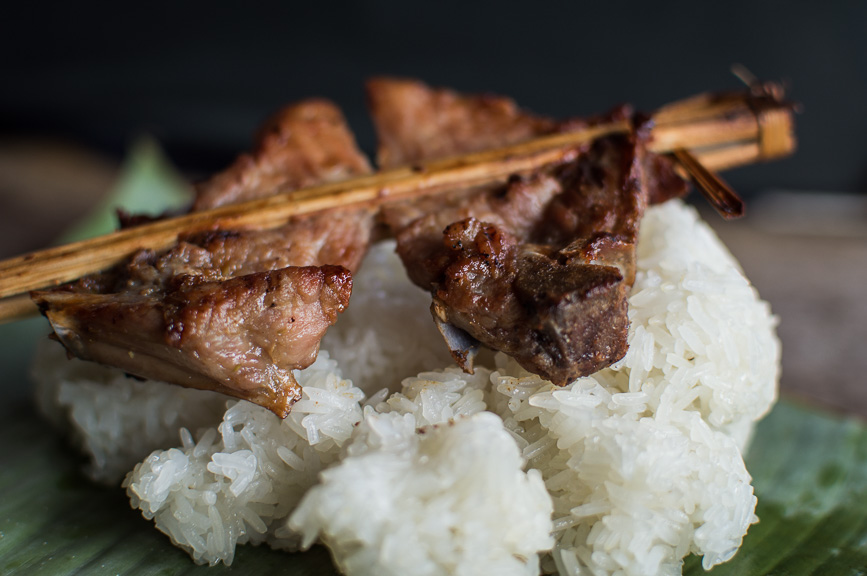
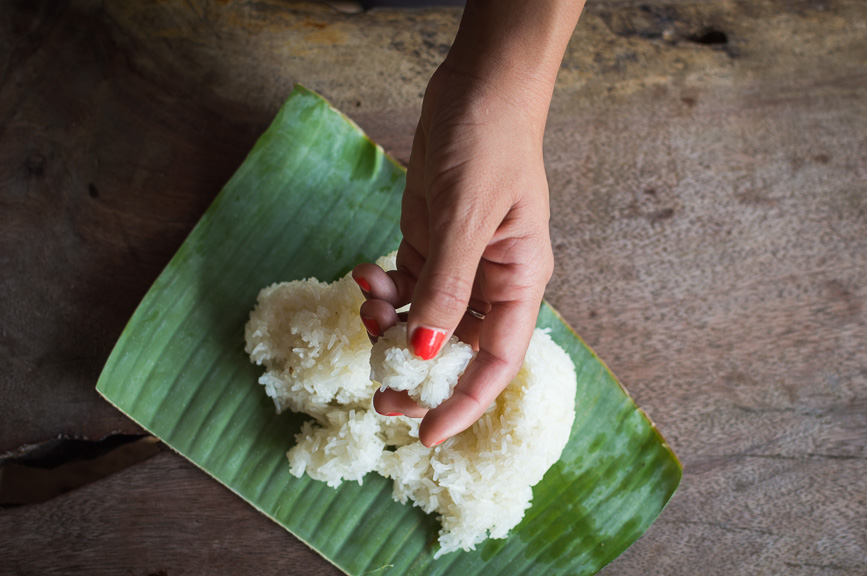
PLAIN & SIMPLE KHAO NIAOW \ˌkʰa᷆w.nǐaw\ ເຂົ້າໜຽວ
Serves 4
2 cups glutinous rice
water for steaming
Soak the rice with enough room temperature water to cover it for a few hours or overnight.
When you are ready to steam it, in Laos they use a houat, a funnel-shaped bamboo basket perched over a deep pot of boiling water, so unless you have one lying around or are using a classic steamer, I find using a metal sieve instead works really well.
For a steamer – If you are using a traditional one like a dumpling steamer, simply place a cheesecloth or a muslin cloth to cover the holes in the steamer and place the soaked rice on top of the cloth. Follow the instructions of your steamer and cook the rice for about 20-30 minutes. During cooking you can shake the rice around a bit to ensure it is evenly cooked through. Don’t do this too often though as you want the rice to stay compact.
For a metal sieve – Fill the bottom of a pot with about 2-3 inches of water and place you metal sieve over it. Make sure the pot is the right size to support the metal sieve and make sure you are not using one with a plastic handle. The sieve should not touch the water. Put the soaked rice into the sieve and cover with a lid. Set the pot over high heat until it reaches boiling point, then turn the heat down so that it continues at a steady simmer. Check after 20 minutes and cook longer if necessary until the centre of the grains are cooked through with a slight bite.
Once the rice is cooked, remove from sieve by flipping it over onto a chopping board and using a wooden spatula spread it out a few times to cool down and even out the heat. Roll it back into a large ball and store in a bamboo basket tip khao or in a bowl covered with a tea towel until you are ready to eat.
Now dig in with your hands! Or try it with our spicy Laos jungle papaya salad.
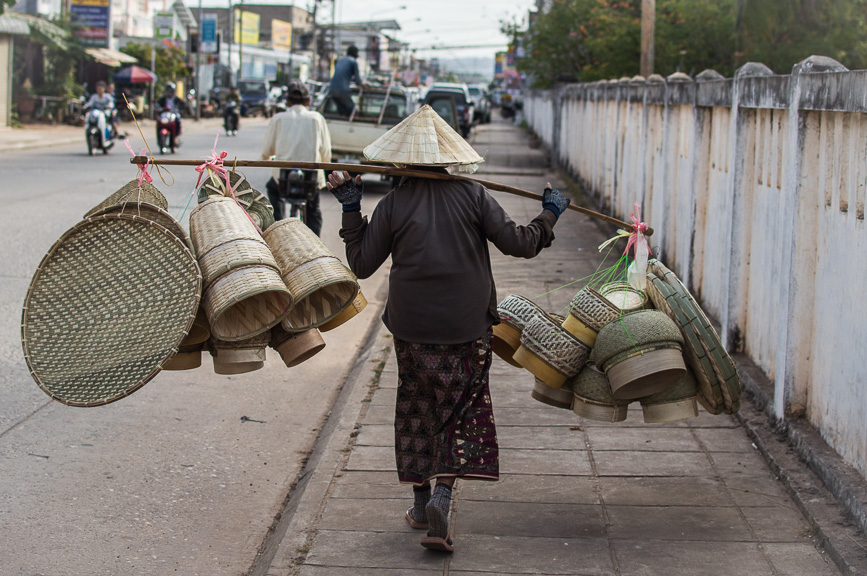

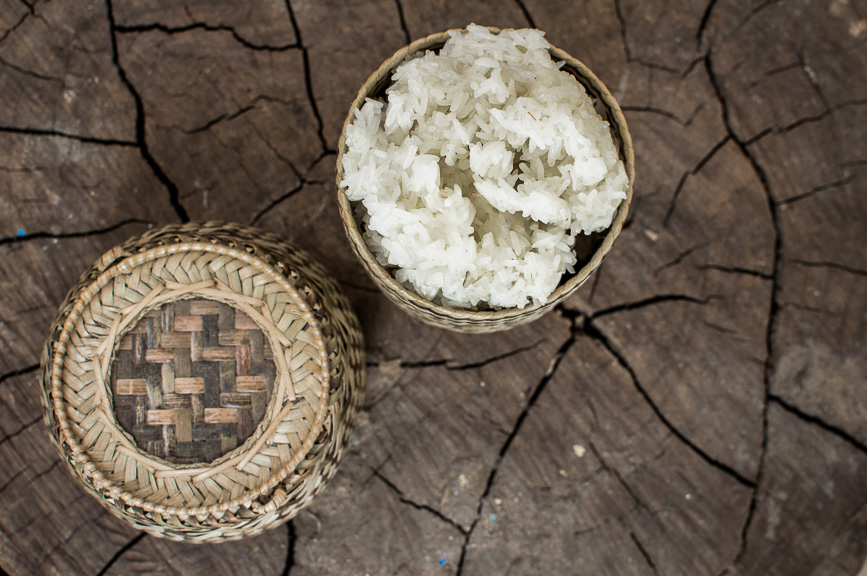










24 Comments
Anna
March 17, 2015I’m in Cambodia now, and heading into Laos in a few days. Consider me a potential pledgeling to your club 🙂 Here in Cambodia they have a fancier take on this that’s quite good too. They mix the sticky rice with some coconut milk and red beans and other magical goodness, and slowly bake it over charcoal inside pieces of green bamboo wrapped in banana leaves. You have to break away the dried out bamboo to get to the chewy rice, but it’s delicious!
Nico & Gabi
March 22, 2015That is great news Anna! Welcome to the club 😉 That sounds absolutely delicious, think they have something similar in Laos and Western Myanmar too, dried out bamboo with sticky rice and peanuts inside one was my favourite, though yours in Cambodia sounds even more gourmet, can’t wait to try it!
indri
March 19, 2015Hi Gabriella,
Im Indonesian currently live in Down Under. We have some snacks made from sticky rice, there are lemper (steamed sticky rice with coconut milk with chicken or beef mince filing), rengginang (crispy fried sticky rice) and some more, but those two are my fave. and there’s also a dessert like sticky rice with manggo, but we’ve ate it with…durian. hopefully you’ll give it a try. till then, enjoy 🙂
Nico & Gabi
March 22, 2015Hi Indri, nice to hear from you and welcome to the club! Can’t wait to try the Indonesian version, never heard of rengginang and it sounds like something I would love as well as lemper! So much to discover, I will need to hunt these down or find an indonesian friend who knows how to make them, thanks for pointing me to your two favourites, yum yum. Will try the durian version too 🙂
tammy
March 27, 2015Sounds yummy! Will try it out sometime!
Nico & Gabi
April 9, 2015We will!
Natasha | Ok, Last Bite.
March 31, 2015I have to confess to never trying sticky rice before (not even the mango dessert that’s ubiquitous to Seattle’s Thai restaurants) but I am so much more than intrigued now. Also, awesome to know the history and the cultural impact that such a simple dish (ingredient?) can have. My boyfriend has spent a lot of time in Laos, and I dream of visiting. Awesome reading, thank you for sharing!
Nico & Gabi
April 9, 2015Thanks Natasha, so happy this has tickled your interest. Definitely try it, a taste of Laos before you get to go!
Qin Xie
March 31, 2015I love sticky rice. It’s used a lot for sweets in Chinese cooking but I’ve always found that western friends have an aversion to it, especially when milled into powder and used for dough. Something about the texture I think.
Nico & Gabi
April 9, 2015Hi Qin Xie, so true! A few of my friends who weren’t used to it were definitely not big fans. Same goes for japanese mochi, like you said, must be the texture. I love any chinese dessert I find made with glutinous rice flour. Need to learn how to make more…
Alexandra
April 6, 2015I only found my love for sticky rice when travelling through Laos a few months ago. I also found it interesting to observe that most Western tourists in Laos would choose “normal” white rice over sticky rice. For me the choice was clear: sticky rice. I haven’t gathered my courage to cook sticky rice myself (yet) but I probably would make it with Larb.
Nico & Gabi
April 9, 2015Hi Alexandra, again so true! Glad you have become a convert though 🙂 We are missing out on so much if we only stick to “normal” rice. Go for it and am sure it will turn out great with your Larb, just the thought is making me hungry.
Julie Neis
April 12, 2015I am president of the Sticky Rice Lovers Who Live In Paris Club. Thailand, really Chiang Mai, was where the obsession began. Eating it straight out of bamboo. Black sticky rice, with seeds and without, sweet and not. I carried around those sticky rice bamboo sticks like a kid with a blanket, fearing that it could possibly be my last. How can I ever like normal rice again?
Nico & Gabi
April 12, 2015Hi Julie, haha glad there is a Paris chapter of the Sticky Rice Club! The sticky rice in the bamboo sticks are my favourite too! I must learn how to make them, though I think finding the bamboo would be the hardest part… Glad you are enjoying living in the City of Light, I lived there for two years as a student, still love going back for weekends.
Padaek
April 12, 2015Hi! Such a great and entertaining post on the beloved khao niaow, and beautiful photos too. Please also add me as a member to the sticky rice club! Learnt many new things here and loving your blog! Please correct me if I’m wrong, but normally naem khao is made with fried steamed jasmine rice, not sticky rice, although there’s possibly several recipes in Laos, one of which uses sticky rice, and I’ve not been back to Laos to confirm. Also, now that you’ve mentioned it, I love the idea of naem khao khao niaow. Yum! 😀
Nico & Gabi
April 12, 2015Hi Padeak, happy to have a new member on board! Love the name of your blog 🙂 Mmm not sure about naem khao usually, when we had it in Vientiane they told us it was sticky rice, but it makes sense that it would be made with steamed jasmine rice too, there must be different ways of making it! Delicious either way 🙂 Will look through your Lao recipes to try out when we have a kitchen again!
Kim
April 12, 2016Hi there,
I’m from Vietnam and I do believe I have sticky rice ingrained in my guts haha. I can’t understand how many people in my country claims sticky rice makes them full, I cannot stop eating once I starts.
We have
xôi xéo: sticky rice cooked with mung bean and salt, top with crunchy fried shallots and a drizzle of lard/oil infused with spring onions
Xôi sắn: cassava cooked with sticky rice
Xôi gấc: from a fruit in Vietnam that mainly provides red colour and light fragrance, with a bit ò sugar , delicious :> often eatin intraditional events
Xôi cốm: sticky rice cooked with green young rice, salt and sugar and a sprinkle of shredded coconut
Xôi vò: Simple sticky rice with mungbean, grains quite light and separated, take a few scoops and mix into a chè (sweet pudding/soup), best eaten hot
Xôi nếp cẩm: Black sticky rice, eaten with mung bean mash (with sugar) and a thick coconut milk syrup
Glad to find someone who loves sticky rice as much as me :>
Kim
Nico & Gabi
April 13, 2016Oh wow, we have obviously found a fellow sticky rice lover in you Kim! And all those xôi from Vietnam makes me want to go back even more! yum yum yum…
Vishal
May 22, 2018oh my goodness! This is the most amazing website ever!!! I was in Laos this last Winter and it was the most magical, entrancing place I’ve ever been; the hidden jewel of southeast Asia. And of course, STICKY RICE!!!!!!!!!! It’s indescribably delicious and undoubtedly one of the most delicious and entertaining foods EVER. I’m so glad there are other people who are as obsessed with Khao Niaow as I am!! Keep up the good work 🙂 !!!!
Nico & Gabi
May 24, 2018Hi Vishal!
So great to find a fellow sticky rice and Laos lover! Welcome to the Sticky Rice Club ;p
Darryl Simpson
July 2, 2018G’day Gabrielle, pfoof! Finally I found someone who loves sticky rice as much as I do. When I was young, we used to go to YUM cha halls here in Australia and I loved the sticky rice parcels wrapped in lotus leaves. Then discovered both black and white sticky rice sweets, I can’t get enough of sweet or savoury sticky rice. Count me in, I’m an addict!!!
Nico & Gabi
July 7, 2018Hi Darryl, fantastic! Always happy to meet a fellow sticky rice addict! I should do some kind of update here or start a real club, think we would build quite a strong base around the world 🙂
Reynaldo M. Lantin
July 2, 2019I would like to obtain seeds of the aromatic sticky rice usually used for the special dish consisting of steamed sticky rice, coconut milk and mango slice, for planting in the Philippines, where we do have the same dish but using the local malagkit or sticky rice variety which is not aromatic. Please give the name of the Lao sticky rice variety and the information for procuring about one kilogram of the rough rice seeds. Thank you.
Sofia
October 12, 2022Any tips for making rice ahead of time , reheating or storing large quantities? Having a bbq so won’t be coming straight from the kitchen and so looking forward to this!